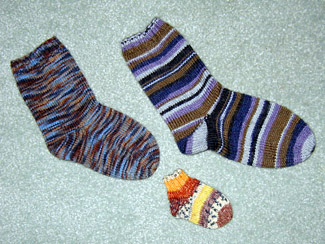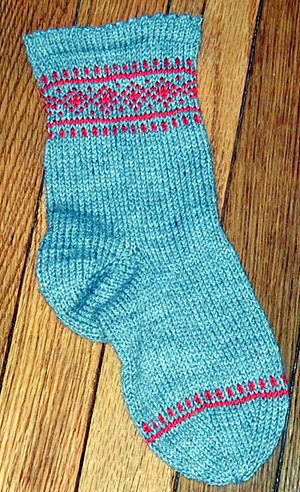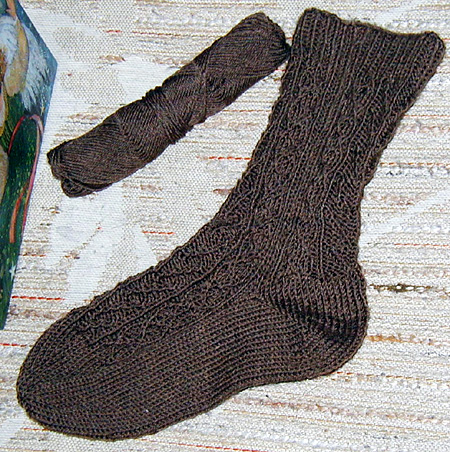Taking your knitting to
the next level
With so many new knitters
coming into the fold, it goes to reason that
there are many 1-2 year knitters out there
who are reaching the breaking point -- the
day when they find that they are no longer
challenged by plain stockinette socks or garter
stitch scarves that originally engaged their
interest in knitting. For me, it was an afghan
of a feather and fan pattern that I fell in
love with and vowed to create as a Christmas
gift for my parents. I bought the yarn
and needles at Wal-Mart along with a "Learn
to knit" book. With the confidence of
youth, I dove right in and ultimately learned
to knit. After I finished the afghan,
I didn't know what to do with my newfound
skill. The afghan was such a lengthy
and boring project that I never wanted to
make another! I tried making a sock,
but knowing nothing about gauge or yarn, made
a total disaster of it. The sock ended
up in the garbage and I had had enough.
Lack of instructional resources and boredom
caused me to reach my breaking point.
I didn't knit again for another decade.
My mother-in-law decided
to knit a sweater for her husband over 20
years ago. The sweater was beautiful, but
the arm lengths were uneven. Not knowing
how to fix the problem and having no one to
ask, the sweater went into a box in the back
of her closet and lives there still.
She reached her breaking point and never knit
again.
This breaking point is the
reason that many quit knitting altogether.
If you have a similar story and are at the
end of your rope [or i-cord], why not "break
away" instead of "breaking down"? By
breaking away, I mean becoming the master
of your own knitting destiny -- charting your
own creative course. The minute you
can take charge of your craft, the boredom
is banished forever. This is a step
that some of the finest knitters in the world
have taken, those that you may know personally
and the designers whose work you admire.
But this is not a right limited to those with
natural skills and decades of experience.
It is available to you and me and everyone
else who has picked up a pair of knitting
needles and fallen in love, no matter how
recently.
Nothing jumpstarts a flagging
interest like a generous dose of creativity.
My purpose is to offer up kernels of creative
knitting thoughts in the hope that one will
produce a spark that becomes a flame. This
"creativity palette" is divided into the 3
areas that define the best of our projects:
color, texture, and shape. These are
the new roads we'll travel. Each area's
skills are in the order from the easiest to
the most difficult. While I used a natural
progression of skill level, please feel free
to investigate any particular area that strikes
your fancy. After all you're charting
your own course, so no rules apply! Later,
we will discuss the resources for your education.

 Beginner:
self patterning yarns. These are so
many self-patterning yarns available today.
There are sock yarns that magically knit up
into stripes, jacquards [fair isle], and variations
in between. There are worsted weights that
knit up in camouflage. Others make more random
color patterns. These yarns are available
at all different price levels, and the added
bonus is that there are no special skills
needed beyond basic knit and purl knowledge.
Beginner:
self patterning yarns. These are so
many self-patterning yarns available today.
There are sock yarns that magically knit up
into stripes, jacquards [fair isle], and variations
in between. There are worsted weights that
knit up in camouflage. Others make more random
color patterns. These yarns are available
at all different price levels, and the added
bonus is that there are no special skills
needed beyond basic knit and purl knowledge.
Intermediate:
stripes and slip-stitch patterns. Stripes
are about the easiest color additions one
can make to knitting, but they add so much
to a plain Jane project. Start small
with a contrasting stripe on the edge of a
waistband or sweater cuff and then work your
way up to completely striped designs.

 Slip-stitch
patterns are another cool way to add color
to your projects with a minimum of skill.
Slip
stitch involves two colors used together
that create a pattern by holding the yarn
of one color to the front or back of the work
and slipping stitches of another color.
This is a good technique to try especially
if you eventually want to learn fair isle
knitting since it will help you become accustomed
to using two strands of yarn without having
to learn color-stranding.
Slip-stitch
patterns are another cool way to add color
to your projects with a minimum of skill.
Slip
stitch involves two colors used together
that create a pattern by holding the yarn
of one color to the front or back of the work
and slipping stitches of another color.
This is a good technique to try especially
if you eventually want to learn fair isle
knitting since it will help you become accustomed
to using two strands of yarn without having
to learn color-stranding.
Advanced:
Intarsia and Fair isle. Intarsia is the technique
of knitting solid blocks of color within a
garment; some examples of intarsia are a desert
panorama on the back of a cardigan or a large
dinosaur on the front of a child's sweater.
Intarsia can be worked back-and-forth or in
the round.
Fair isle is the color-loaded
knitting technique made popular by the Scots,
but usually only two to
three colors are used in the same row
to create various patterns. The unused
colors are stranded in "floats" that are caught
up on the wrong side of the work until you
are ready to use them. It makes a colorful
and thick fabric, perfect for sweaters, hats,
mittens and socks. There are a variety
of techniques for knitting fair isle which
include one- and two-handed knitting.
Beginner:
Simple stitch repeats and ribbings. Texture
is the heartbeat of a design and affects the
drape and look of your garment. It's
recommended that your first foray into texture
are with simple pattern repeats that are easy
to remember such as garter stitch, seed stitch
or ribbing.

 Intermediate:
charted stitch patterns. There
is no limit to the variety of stitch patterns
available: from chevrons, to herringbones,
to openwork [lace]. These stitch patterns
have a large number of stitch repeats and
are created over several rows of knitting.
These stitch patterns are usually charted
to allow the knitter to visualize the knitting
process and finished product.
Intermediate:
charted stitch patterns. There
is no limit to the variety of stitch patterns
available: from chevrons, to herringbones,
to openwork [lace]. These stitch patterns
have a large number of stitch repeats and
are created over several rows of knitting.
These stitch patterns are usually charted
to allow the knitter to visualize the knitting
process and finished product.
Advanced:
Cables, bobbles, and twisted stitches. Cabling
involves knitting stitches out of order by
holding the stitches you would normally knit
to the front or back of the work [on a cable
needle]. The neighboring stitches are
knit, and then the held stitches are knit.
After several rows, a pattern develops that
looks like twisted rope. Bobbles are
stitches that are created in several ways,
but usually involves knitting into stitches
repeatedly, the end result is a bubble of
fabric that is used as a design accent or
as a functional object like a button.
Twisted stitches are sometimes called Bavarian
or Austrian stitches. The technique
involves knitting and purling into the back
of stitches to create a design in relief.
This technique also can involve cabling with
or without the aid of a cable needle to make
a textured pattern which really "pops" against
a purled background.
Beginner:
Circular knitting. Shaping is what makes knitting
both sculpture and clothing. Most of
us learned to knit on straight needles to
create a flat finished product, which in itself
holds a variety of possibilities when seamed
in different ways. But what if you could
knit tubes of fabric which would make a seamless
fabric and could be applied to something as
big as a sweater body, or as small as the
finger of a glove? Circular knitting
provides just that thing, and the added bonus
is that it is [usually] faster and easier
than flat knitting since it eliminates the
need for purling or seaming. Circular
knitting is accomplished on 4-5 double pointed
needles or 1-2 circular needles. Many
top knitters of the past and present [including
the prolific Elizabeth Zimmermann] consider
circular knitting to be the ultimate in knitting
nirvana.
Intermediate:
Short
rows. Knit-in shaping is what we're
talking about. Short row knitting is
simply the technique of turning the knitting
to work the wrong [other] side before
reaching the end of the row. The technique
of knitting and turning is done back and forth
to achieve different types of shaping.
When done according to directions, short row
knitting will create triangles, curves, darts
and cups. Common uses of short rows: sock
heels, bust shaping on sweaters, curves on
doilies and dishcloths.
Advanced: Steeks.
The first time steeks were described to me,
I commented, "Knitting stitches only to C-U-T
them later?" The idea seemed blasphemous,
but that's exactly what steeks are.
They are usually executed in sweaters to allow
the sweater body to be knit circularly.
The steeks are then cut and the sleeves are
attached. I'm cheating a bit by calling
this an advanced technique as steeks are not
nearly as difficult as they seem. Although,
I do believe that you might have to get to
an advanced level to have the GUTS to try
steeking.
Clearly all the creative
techniques available for exploration have
not been mentioned here. There's still
double knitting, knitting with wire, felting,
free form and the list goes on. But
hopefully one of the techniques mentioned
has piqued your interest. In conclusion,
the most important thing to do when an interest
develops is to indulge it. Like the
commercial says, "Just do it." But before
you drop a huge wad of cash on all the yarn
needed for a fair isle sweater, pick up some
scrap yarn and knit a swatch full of colorful
stripes or crazy cables. Or make your
swatch big enough to be a dishcloth.
Not only will you build confidence along with
your skills, you will have made something
useful as well. Below are some resources
for advancing your skills:
Your local library:
I always head here first. A well-stocked
library will have an array of books on different
techniques. This is also a great way
to preview books you may want to purchase
later and it's all for free. Most libraries
also offer internet access which is helpful
if you don't have a computer at home.
Your local yarn
store: You get double value
here: experience and product. The salesperson
will be able to advise you on yarn, patterns
and videos/literature that will help you.
Don't be afraid to ask specific questions
about a project or pattern. Take advantage
of any classes that are offered. If
you don't have a local yarn store, find an
online yarn store you like. Many online
store owners don't mind answering customer
questions.
Knitting guilds:
Formal and informal knitting groups invariably
have members with different skill levels.
There is bound to be someone who can show
you how to turn a heel or make a cable.
Internet: The
resources available via the internet are almost
infinite─from online magazines to personal
weblogs. There are websites that offer
instructions on techniques from kitchener
to fair isle. Some even have videos.
Try googling around for your interest ─for
example: enter a search for "short row heels".
You are bound to have several hits that lead
to great instructional information.
One of the most valuable
resources I've found are online knitting groups
and message boards. Most are available
for free and offer instant access to other
knitters who are only too pleased to answer
any questions you might have. It's also
nice to live vicariously through a knitter
who's neck deep into a Kaffe Fassett pattern.
You may not be ready for such a difficult
pattern, but pay attention and you may be
closer than you think. A couple of sources
for such groups would be Yahoo Groups and MSN Groups. Also, be sure to check
out any links listed on your favorite websites.
They're sure to lead to new pleasures.

